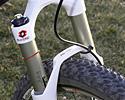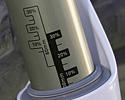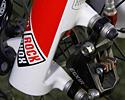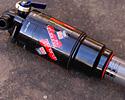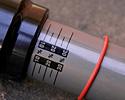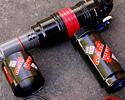
Recently on Cyclingnews.com |
On test: RockShox SID Team & Monarch, December 3, 2008
Not just for racing anymore
The RockShox SID has been the most successful fork on the World Cup cross-country circuit in history but it was long overdue for a major overhaul. Cyclingnews technical editor James Huang finds the new version to be vastly improved in every way but one – SID isn't just a racer's fork anymore.
The venerable RockShox SID platform was many things to many people but two things had always remained constant: it was one of the lightest forks available but also among the flexiest and most unpredictable in technical terrain. Thankfully, this latest iteration firmly puts that old reputation to bed with a new trail bike-stout chassis, competitively light weight and highly tunable and effective internals that should not only keep it at or near the top of racers' wish lists, but also make it a viable short-travel all-purpose trail fork, too.
The new SID grows in size in nearly every dimension: the straight-walled 7000-series aluminum stanchions are now a healthy 32mm instead of an anemic 28mm; the beefier cast magnesium lowers feature a more heavily bolstered arch and Power Bulge reinforcements around the lower bushings to combat flex under load; and the new forged AL66-TV aluminum crown bears a wider stance.
Weight is kept in check with shorter stanchions and internal shaft lengths which also decreases oil volume. Though RockShox had originally hoped to roughly match the old SID on the scale as a result, our numbers suggest that it fell well shy. A previous generation SID World Cup was just 1375g (3.03lb) with a Pushloc remote and uncut carbon steerer; our comparably equipped 2008 SID Team tester is markedly heavier – though still lightweight – at 1585g (3.49lb).
Only weight weenies are likely to complain about the extra mass, though, as the difference in chassis rigidity is like night and day on the trail. Gone is the vague steering, the floppy braking, and that unnerving ‘hmm, I wonder where my wheel is going to go?' question that always seemed to haunt SID users on technical terrain.
In its place is a more confidence-inspiring and secure feel that holds its line far more faithfully than before, even on our demanding test grounds of Colorado's Front Range, Gooseberry Mesa and Moab in nearby Utah, and the (literally) backyard stunts and trails of SRAM product guru Greg Herbold.
Adding to the new SID's capabilities are its highly evolved internals which include the well-proven – and highly tunable – Dual Air spring system and updated Motion Control damper. In the case of our mid-level SID Team version, the BlackBox compression assembly also upgrades to a titanium spring tube for lighter weight. A printed-on inflation guide and permanent sag markings speed setup (though we consistently ran lower pressures than recommended) and both the compression and rebound dampers offer a suitably wide range of adjustment.
The refined guts yield real dividends when tires meet dirt: trail chatter is effectively canceled out and this new SID displays impressive composure through nasty rock gardens that its ancestor could only dream of. Though our early sample initially included a Floodgate blow-off valve that was too firm for our liking, it was quickly replaced by a later production assembly that was more in keeping with the Reba and all current samples should be so-equipped.
Niggles are few and relatively minor in light of the fork's otherwise superb overall performance. The recessed lower legs may help shed some grams but they also make the rebound adjuster knob and negative air spring cap hard to access, especially for those with bigger fingers. Our Pushloc remote lockout also proved a bit stubborn to return to the open setting without unweighting the front end and regular running in dry desert conditions required relatively frequent oil bath service to maintain optimal running.
Otherwise, we have nothing but praise for this little-fork-that-could. Anyone want to buy an old SID, cheap?
Price: US$721 (with crown-mounted lockout knob); US$789 (with Pushloc remote)
Weight: 1585g (3.49lb) (100mm travel, uncut steerer, with Pushloc remote, cable and housing); 1498g (3.30lb) (with crown-mounted lockout knob)
Pros: Trail bike-like steering precision and stout feel paired with race bike weight, intuitive setup, wide range of tunability
Cons: Oil bath requires frequent service in dusty conditions, rebound knob and negative air cap are difficult to reach, Pushloc remote somewhat temperamental, substantially heavier than its predecessor
Cyclingnews rating: ![]()
More information: www.rockshox.com
![]()
Monarch: SID's perfect match
|
|
|
|
|
|
|
RockShox has often struggled with its rear shocks but its latest Monarch line for cross-country and trail bikes finally has what it takes to go toe-to-toe with the current industry benchmark, Fox Racing Shox' RP23.
Housed within the compact body of our top-end Monarch 4.2 model is essentially a miniaturized version of the Motion Control damper used in the SID complete with similar adjustments: Floodgate on/off, blowoff threshold, and rebound speed, all accessed via high-quality machined and anodized aluminum knobs. Though the air spring switches to RockShox' simpler Solo Air setup rather than the more complex Dual Air, negative and positive pressures are automatically equalized for the smoothest possible ride.
Not surprisingly, the Monarch provides the same ride quality out back as the SID does up front and is impressively RP23-like. Small and large impacts alike are exceptionally well controlled and the damper adjustments offer an impressively wide range. In addition, the standard air can is far less spikey than earlier RockShox renditions but if it is still a bit too progressive for your liking, there is also a cleverly designed high-volume option that can be adjusted without tools to dial in your desired spring rate.
Weights are comparable as well: our 200x50mm sample is just 234g without hardware vs. 244g for the RP23. The high-volume option adds another 36g.
Most impressive, however, is how much smoother the Monarch made our test bikes feel throughout the travel range though it's not due to any internal improvements over the RP23. RockShox fits the Monarch with its own hard anodized aluminum hardware that yields lower friction than the usual raw aluminum stuff; it rotates far easier and even presses in with less effort with no tools required.
As with the SID, downsides are few and trivial in nature. About the only thing we could come up with is the somewhat hard-to-reach rebound adjuster knob which we are almost willing to overlook in light of the handy flip-out air valve.
If you already have an RP23, the Monarch 4.2's comparably excellent performance alone isn't enough to justify the cost of the swap. However, those looking to upgrade from something lesser should pay the Monarch 4.2 a hard look and the hard anodized RockShox hardware (which will fit Fox eyelets) is an absolute no-brainer.
Price: US$309-345 depending on size, plus mounting hardware
Weight: 234g (200x50mm, standard air can, without hardware); 270g (200x50mm, high-volume air can, without hardware)
Pros: Well-controlled compression and rebound stroke throughout travel range and in variety of conditions, wide adjustment range, exceptionally smooth hard anodized hardware, flip-out air valve, good reliability
Cons: Rebound adjustment knob is somewhat hard to access
Cyclingnews rating: ![]()
More information: www.rockshox.com
For a thumbnail gallery of these images, click here
Images by James Huang/Cyclingnews.com
- The new RockShox SID Team offers a tremendous performance improvement over its predecessor.
- Stanchion diameter has increased from 28mm to 32mm and permanent sag gradients offer a convenient visual aid in tuning.
- Power Bulge reinforcements around the lower bushings supposedly combat flex during hard impacts.
- RockShox also equips the new SID with a beefier arch.
- The refined BlackBox Motion Control internals provide excellent control on both small and big hits.
- Dual-flow rebound circuits provide good control even on deep-stroke impacts though the knob is hard to access.
- The new lower legs switch from International Standard to 74mm post mounts for easier brake installations.
- Two threaded holes built into the back of the arch provide a convenient mounting point for a bare bones fender.
- RockShox finally has a genuine RP23 fighter in its Monarch 4.2 rear shock.
- Adjustments are comparable to those on the SID: air pressure, Floodgate on/off, Floodgate blowoff threshold, and rebound speed.
- Permanent sag gradients offer easy visual cues to aid in tuning.
- The hard anodized hardware is noticeably smoother than standard stuff and should be an automatic upgrade for current RP23 users.
- RockShox also offers a high-volume air can option for those that want a more linear stroke. The volume can also be fine-tuned without the use of tools.

